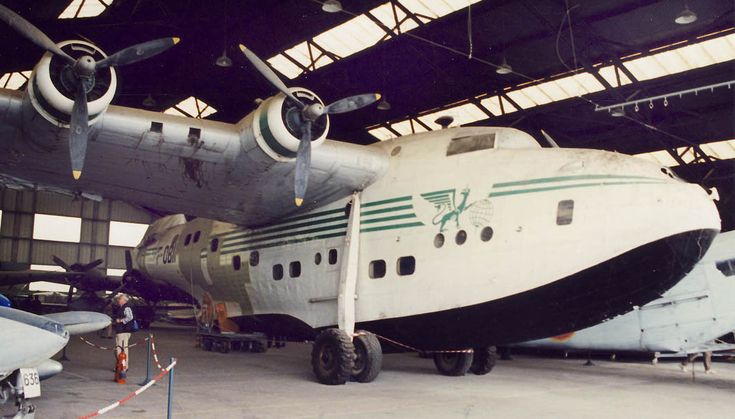
One of the Sandringhams operated by RAI in the early days.
by Steve Mackenzie

One of the Sandringhams operated by RAI in the early days.
In my opinion one of the nicest looking civil types around is the De Havilland Canada DHC-6 Twin Otter' turbo prop commuter a/c. This type has appeared in hundreds of colour schemes around the world and would make a fine addition to any model collection. As I have mentioned in the last couple of editorials, the intention is to present some more Twotter material based on photos of airframes that have been operated in our local region (Aust, Pacific, New Guinea etc). There have been probably thousands of schemes applied to this type world wide since they first went into service in the 60s as many airframes have been passed down from one operator to another over the years. Although many of these schemes were very nice, I will in general restrict things to aircraft that are more relevant to our status as an Aussie based mag.
One area to closely look at in photos of these aircraft and the accompanying drawings is the aerial fit which varies enormously between different operators and in some cases individual machines in the same company. Another thing to watch for (although it does not apply to any of the aircraft drawn here) is that some machines have an additional window in the airstair door on the port side. If necessary you will have to cut and glaze a window to match.
Although quite a few of the overseas Twin Otters can be seen in very colourful overall paint schemes, the local machines (from Australia and our Pacific neighbours) appear to mostly be in Gloss White with coloured cheat lines etc added. Most companies have some sort of Gloss Black area around the engine nacelles and sometimes the horizontal tail surfaces also to hide the exhaust stain. This varies between operators and the drawings should be observed carefully. Some machines carry deicing boots on the leading edges of wings and tailplanes ( this can be either Black or a light buff colour).
So onto some additional schemes which I have not presented before in previous issues. I have many more... Steve Mackenzie
In this part I have concentrated on the Airlines in French Polynesia which have operated DHC-6 Twin Otters, which basically means Air Tahiti (under various names over the years, they keep changing) plus a couple of other operators. It was not until the Second World War that aviation took off in French Polynesia (which is an overseas territory of France), with the construction of the first airstrip in 1943, in Bora Bora, by the US military. In 1950, a group of entrepreneurs founded Air Tahiti, which is actually unrelated to the current Air Tahiti. They used small amphibious types to connect to the outer Islands (due to the then lack of airstrips).
In July 1953, Transports Aeriens Intercontinentaux (TAI) later RAI was formed to operate of local transport services, under agreements signed with Air France. The territorial government withdrew Air Tahiti's operating licence for the Mallards, in favour of the TAI, and with it, the Air Tahiti emblem disappeared (for a time). The TAI operated on behalf of the ministry of public works and transport. It purchased two Catalina seaplanes to expand the service linking the islands of French Polynesia. These orange-liveried aircraft received a registration number with the prefix F-OA, reserved for aircraft operated overseas. The parent company also operated other types based in France and later extended operations to the Pacific (they even flew to Darwin at one stage - see the Wikipedia entry on them for more info).They later added 2 Short Sandringham airframes and other types including a DHC-6 Twin Otter (F-OCLV) to operate to the airstrips that were being built by the local Govt on outlying islands.
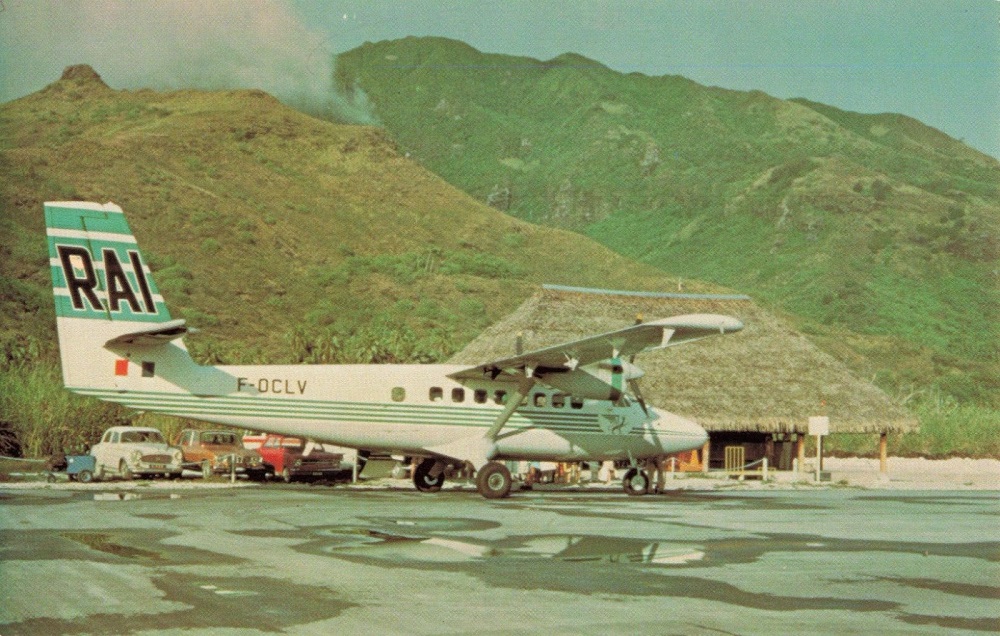
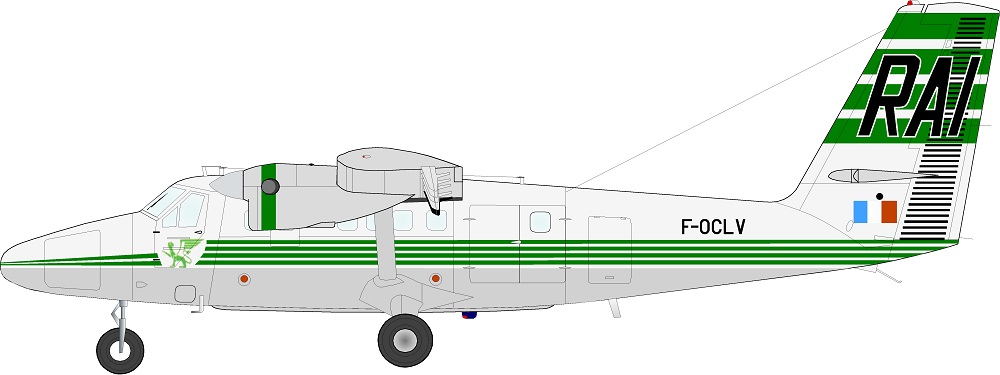
DHC-6 Twin Otter c/n 149 of RAI late 1960s. White upper fuselage with Light Grey lowers, wings, horizontal tailplanes and cowlings. Green (it varies between dark and lighter in different images) stripes and nose insignia. 'RAI' is Black with white outlines and Rego F-OCLV in Black. French flag under tailplanes.
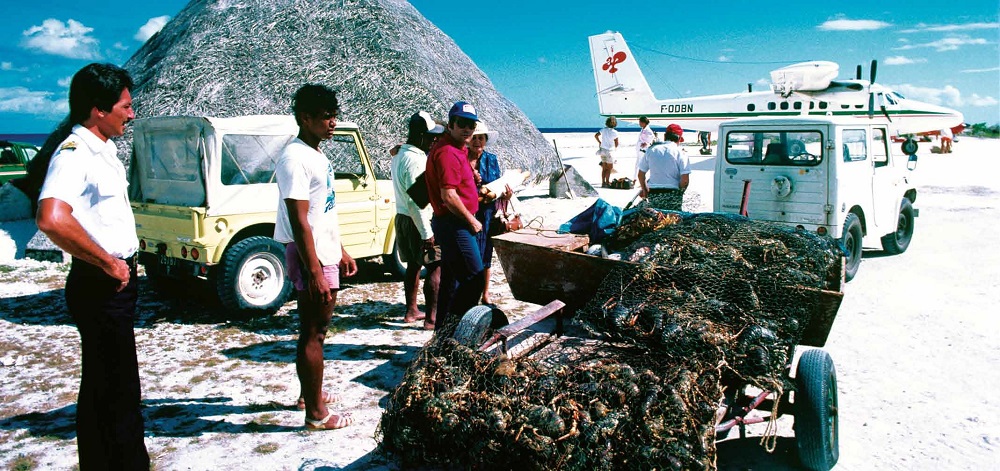
DHC-6 F-ODBN of 'Air Po', not the best image, there are better ones on the net, but they are copyrighted.
In 1970, RAI became Air Polynesie, a subsidiary of UTA. Nicknamed 'Air Po' by the Polynesians, the airline further asserted its Polynesian identity, putting in place scheduled flights throughout French Polynesia, in particular to the islands furthest away from Tahiti. They operated two DHC-6 airframes (F-OCFJ again and F-ODBN)
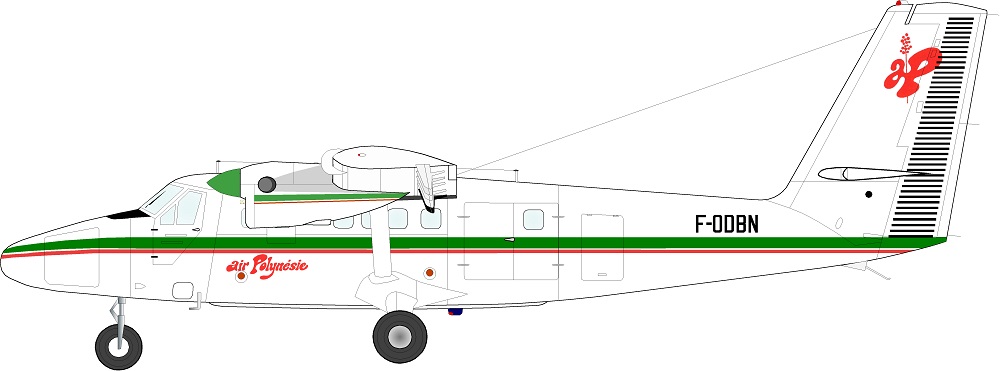
DHC-6 Twin Otter c/n 470 of Air Polynesie 1980s. White overall fuselage with Green stripes, spinners (White in the above image but some others show Green) etc. Titling and narrow stripe in Red. Rego, Anti-glare panel (shows on other images) and area to cover exhaust strains on wings are Black with light Grey areas on the engine cowls for the same reason. (there are a number of the small changes in this scheme in the 7-8 images I have).
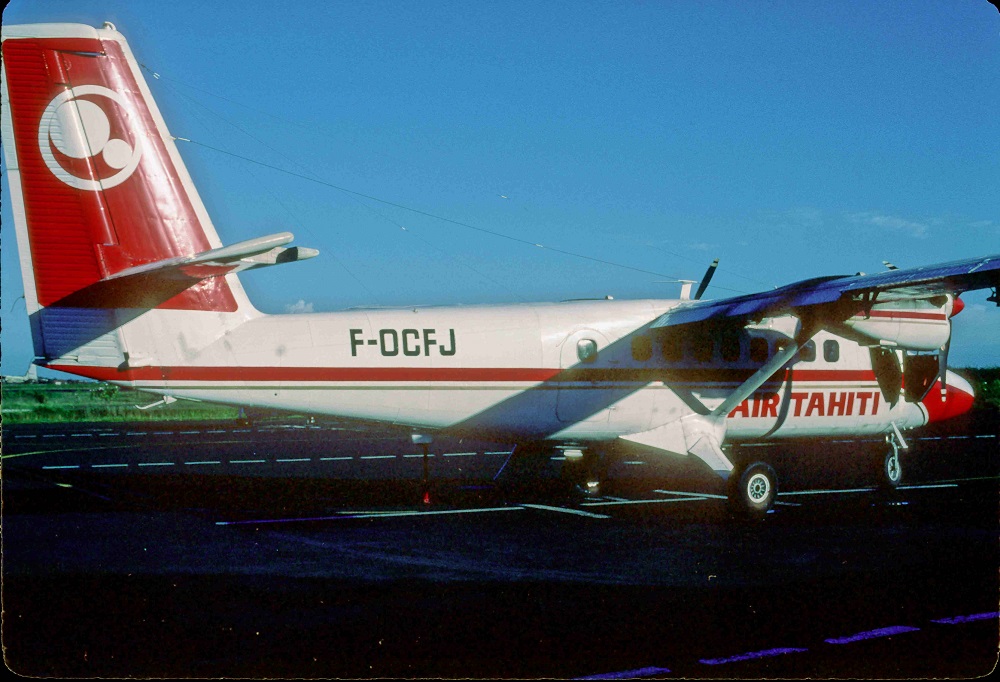
F-OCFJ with AirTahiti titles.
The company become Air Tahiti during the late 1980s according to the Histories (which does not explain jetphotos.com/photo/242263 which it says was taken in 1979, I suspect a typo for 1989). Currently, the airline owns a diverse fleet of 14 aircraft, including three Beechcraft King Air B200s and 7 ATR-72s. They have operated at least three Twin Otters (F-OCFJ, F-ODBN and F-ODUH in Aug 1987 - 1991).
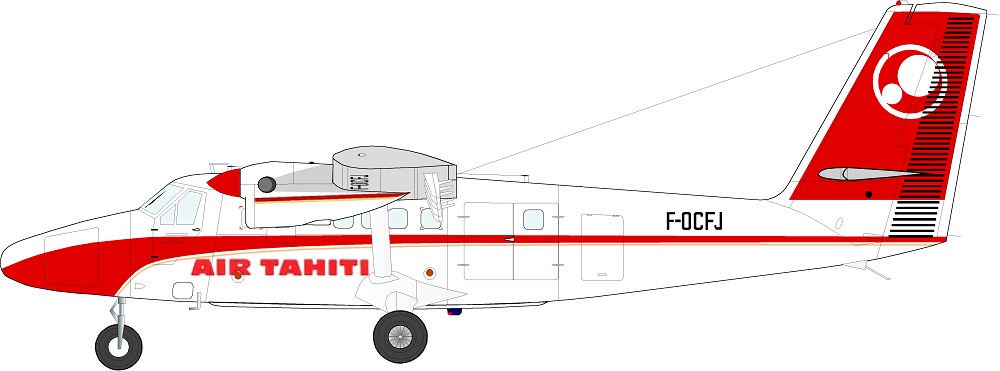
DHC-6 Twin Otter c/n 149 of Air Tahiti 1987-1991. White overall fuselage with large areas and stripes, spinners etc in Red with coppery Yellow minor striping. Light Grey areas to cover exhaust stains, wings and horizontal tailplanes. Black Regos.
In 1991 the local inter island operations were hived off under the name Air Moorea (Moorea is one of the biggest groupings in the Island chain) and the Twin Otters were transferred to them . Below is F-ODUH being operated by Air Moorea (but with Air Tahiti logo still on the tail).
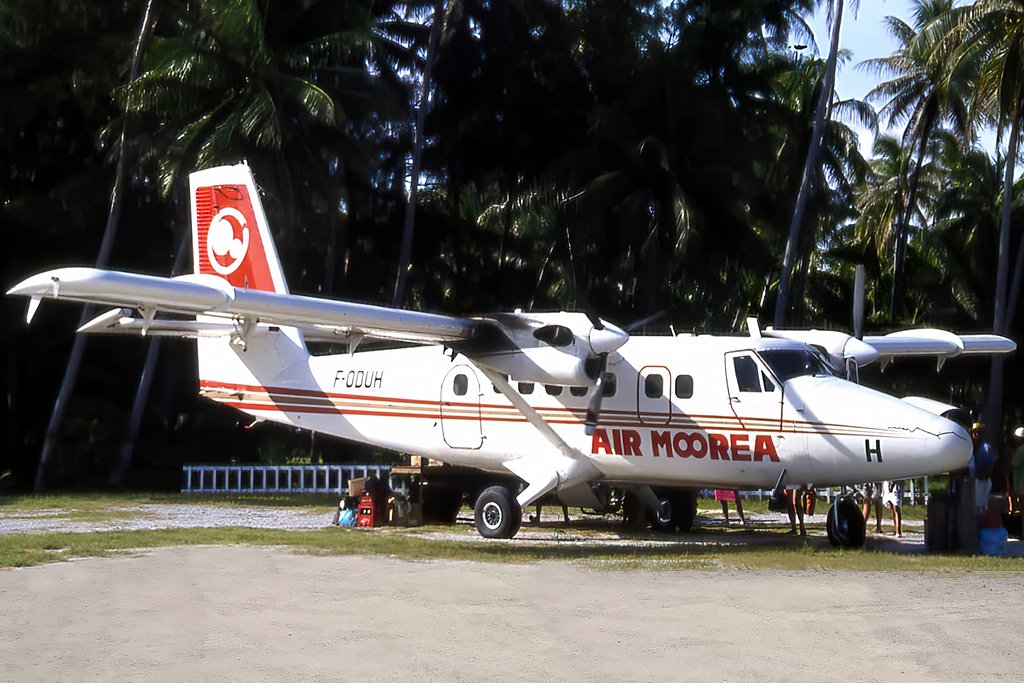
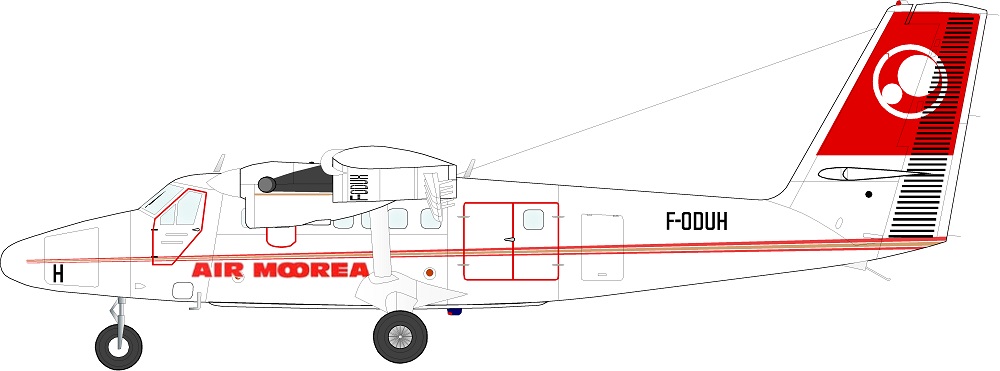
DHC-6 Twin Otter c/n 696 of Air Moorea 1991 (it was disposed of that year). White overall with large coloured area and logo on tail in Red with coppery Yellow and Red striping. Dark Grey/ Black areas to cover exhaust stains. Black Regos.
There are several images of F-ODBN in the following scheme which seems to have been the initial Air Moorea colours such as https://twinotterworld.com/msn-470?itemId= and https://www.jetphotos.com/photo/115637.
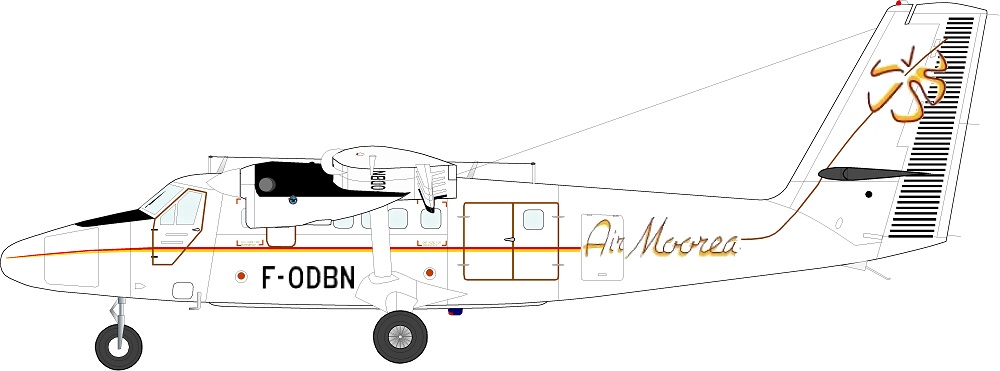
DHC-6 Twin Otter c/n 470 of Air Moorea 1993. White overall with Yellow/Black flowers and striping. Black Regos, areas to cover exhaust stains, anti-glare panel and outer halves of horizontal tailplanes.
F-ODUH was disposed of in Feb 1991 and F-ODBN in Sep 2010 (F-OCFJ went earlier in Jan 1987). The replacements were F-OHJG and F-OIQP which were acquired (according to the Twin Otter database) in 2008. Around that time the company made their scheme a lot more fancy with four flower insignias placed along the fuselage and the company name in more prominent lettering.
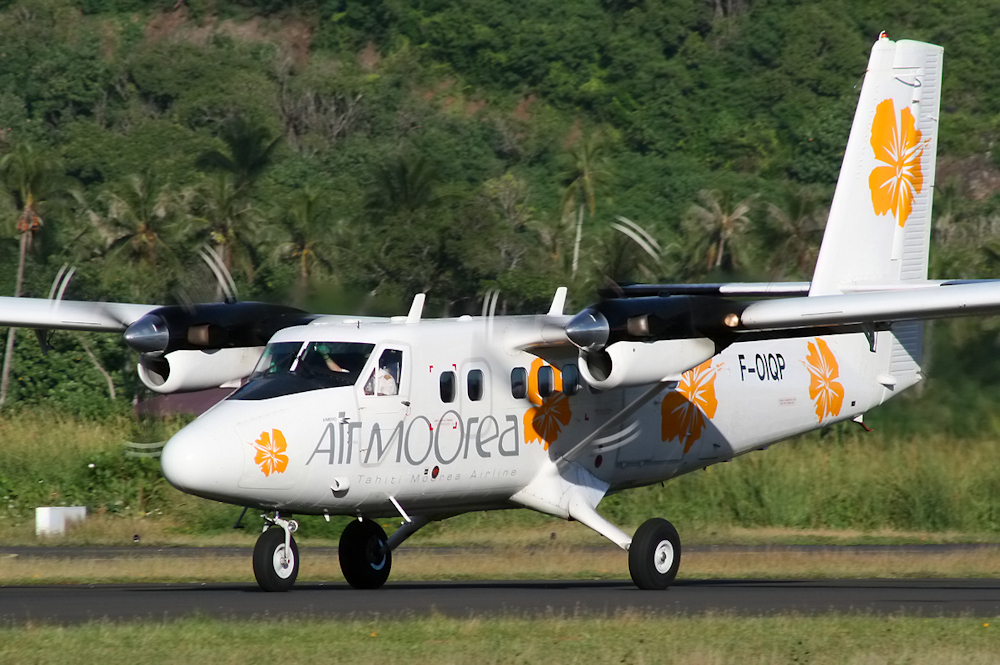
F-OIQP photographed in 2010 at Moorea.
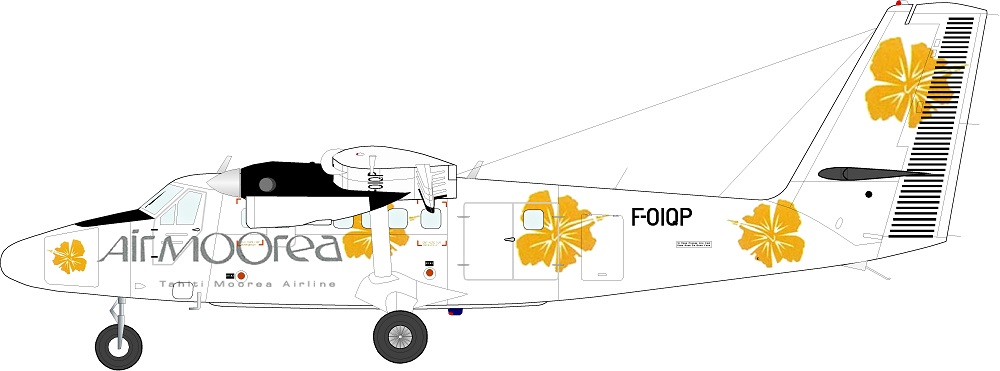
DHC-6 Twin Otter c/n 715 of Air Moorea 2010. White overall with four Yellow/Orange flowers placed along the fuselage and tail. 'Air Moorea' titles etc in Med Grey. Black Regos, areas to cover exhaust stains, anti-glare panel and outer halves of horizontal tailplanes. Polished Metal spinners.
Click on the 'Next' button to go to Page 2 of the article